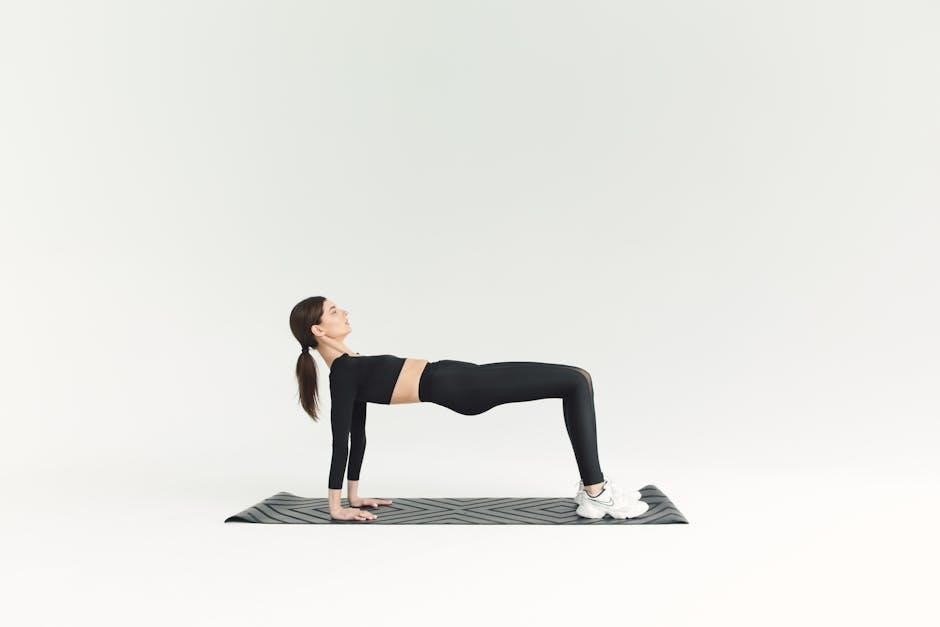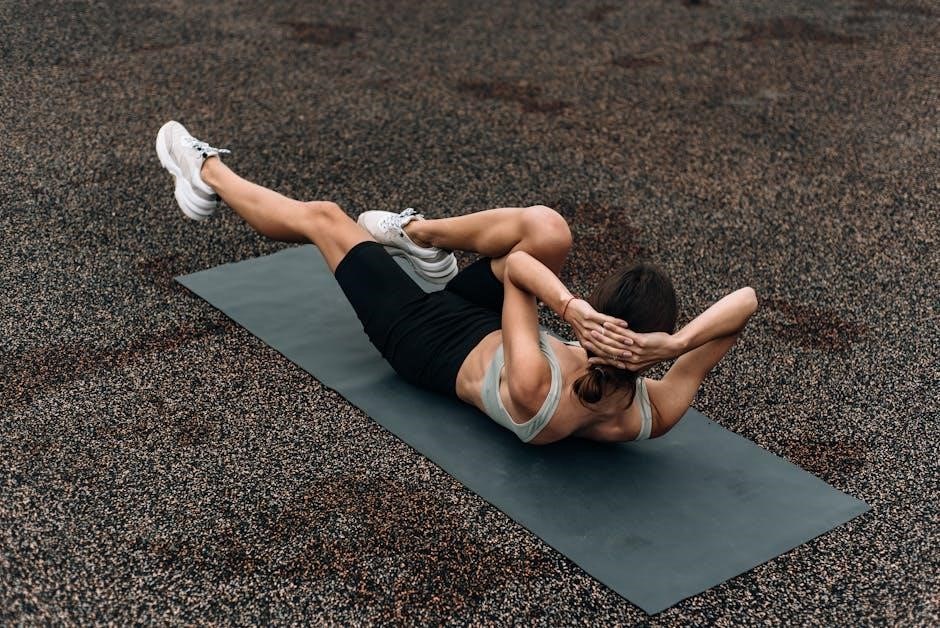Calisthenics training is a bodyweight-based fitness method requiring minimal equipment, emphasizing functional strength and mobility. It’s accessible for all fitness levels, promoting full-body conditioning through exercises like push-ups, squats, and lunges effectively.
1.1 What is Calisthenics?
Calisthenics is a form of exercise that uses body weight as resistance, requiring minimal equipment. It focuses on functional movements like push-ups, squats, and lunges, improving strength, flexibility, and coordination. Originating in ancient Greece, it’s a holistic approach to fitness, suitable for all fitness levels, and emphasizes natural movement patterns to enhance overall physical conditioning effectively.
1.2 Benefits of Calisthenics Training
Calisthenics training improves functional strength, mobility, and coordination while enhancing cardiovascular health. It’s cost-effective, requiring minimal equipment, and can be done anywhere. The exercises promote muscle balance, reducing injury risks, and are adaptable to all fitness levels. Regular practice boosts mental discipline, consistency, and overall physical resilience, making it a versatile and effective approach to holistic fitness and well-being.
Getting Started with Calisthenics
Begin with basic exercises, minimal equipment, and a dedicated space. Start slow, focus on form, and gradually increase intensity to build strength and consistency effectively.
2.1 Essential Equipment Needed
Calisthenics requires minimal equipment, focusing on bodyweight exercises. A sturdy pull-up bar, parallel bars, and open space are essentials. Resistance bands or a gymnastic mat can enhance workouts for added challenge and comfort. Basic equipment ensures accessibility, allowing you to train effectively anywhere, anytime, without reliance on heavy machinery.
2.2 Setting Up a Training Space
Creating an effective training space involves ensuring safety and accessibility. Choose a flat, open area with enough room to move freely. Install a sturdy pull-up bar and parallel bars for upper-body exercises. Use non-slip flooring and ensure proper ventilation. Keep the space clutter-free to prevent accidents and allow for smooth transitions between exercises. Natural lighting and a clean environment enhance focus and motivation during workouts.

Core Calisthenics Exercises
Core calisthenics exercises include push-ups, pull-ups, squats, dips, and planks. These bodyweight movements build strength, endurance, and flexibility, forming the foundation of a balanced workout routine.
3.1 Upper Body Exercises (Push-Ups, Dips, etc.)
Push-ups and dips are fundamental upper body exercises in calisthenics, targeting the chest, shoulders, and triceps. Variations like diamond push-ups or tricep dips increase difficulty. These movements improve strength, endurance, and overall upper body muscle development, making them essential for a well-rounded workout routine.
3.2 Lower Body Exercises (Squats, Lunges, etc.)
Squats and lunges are cornerstone lower body exercises in calisthenics, enhancing strength, mobility, and balance. Squats target the quadriceps, hamstrings, and glutes, while lunges improve unilateral strength and stability. Variations like pistol squats or jump lunges add complexity, ensuring continuous progression and comprehensive lower body development for functional fitness and overall athleticism.
3.3 Full-Body Exercises (Burpees, Jump Squats, etc.)
Full-body exercises like burpees and jump squats combine strength and cardio, engaging multiple muscle groups simultaneously. They enhance coordination, agility, and overall fitness. Burpees work the arms, legs, and core, while jump squats boost explosiveness and cardiovascular endurance. These exercises are versatile, scalable, and ideal for high-intensity interval training (HIIT), making them a cornerstone of advanced calisthenics routines for improved functional fitness.

Structuring a Calisthenics Workout Plan
A well-structured calisthenics plan balances upper, lower, and full-body exercises, ensuring progression and consistency. It incorporates warm-ups, targeted routines, and cool-downs to maximize efficiency and prevent overtraining effectively.
4.1 Warm-Up and Mobility Routines
A proper warm-up and mobility routine are essential to prepare the body for calisthenics training. Begin with light cardio like jumping jacks or jogging in place to increase blood flow. Incorporate dynamic stretches such as arm circles, leg swings, and torso twists to enhance joint mobility. Mobility exercises like shoulder rolls and hip openers improve flexibility and reduce injury risk, ensuring optimal performance during workouts.
4.2 Session Duration and Frequency
Calisthenics sessions typically last 30-60 minutes, varying by fitness level and goals. Beginners might start with shorter, 30-45 minute workouts, 3-4 times weekly. Intermediate trainees can aim for 45-60 minutes, 4-5 times a week. Advanced individuals may opt for longer sessions, 60-75 minutes, 5-6 times weekly, focusing on intensity and volume to maximize progress and strength gains effectively.
4;3 Incorporating Progressive Overload
Progressive overload is key to advancing in calisthenics. Gradually increase reps, sets, or difficulty over time. For example, start with basic push-ups, then progress to incline or single-arm variations. This approach ensures continuous strength gains and prevents plateaus. Consistency and patience are vital for long-term progress in bodyweight training effectively.

Nutrition for Calisthenics
Proper nutrition is essential for calisthenics, focusing on balanced caloric intake, macronutrient ratios, and hydration to fuel workouts and aid recovery. Apply the 80/20 rule for optimal results.
5.1 Caloric Intake and Macronutrient Balance
Caloric intake and macronutrient balance are crucial for calisthenics, ensuring energy and recovery. Aim for a diet rich in carbohydrates for energy, protein for muscle repair, and healthy fats for hormone function. Tailor caloric consumption to match training intensity and goals, applying the 80/20 rule for balanced nutrition and performance optimization. Proper ratios fuel progress and overall well-being effectively.
5.2 Hydration and Recovery Strategies
Proper hydration is vital for performance and recovery in calisthenics. Aim to drink at least 3-4 liters of water daily, adjusting for sweat loss. Recovery strategies include post-workout stretching, foam rolling, and adequate sleep. Incorporate rest days to allow muscle repair and growth, ensuring optimal progress and injury prevention. Consistent recovery practices enhance overall training efficiency and long-term sustainability.

Progression Techniques
Master fundamentals, then gradually increase intensity by boosting reps, sets, or difficulty. Incorporate advanced variations and progressive overload to continuously challenge muscles and enhance strength over time.
6.1 Increasing Repetitions and Sets
Increase repetitions and sets gradually to build strength and endurance. Start with manageable volumes, then progress by adding reps or sets weekly. For example, begin with 3 sets of 10 push-ups and aim to reach 4 sets of 15; Consistency is key to muscle adaptation. Track progress to ensure steady improvements over time.
6.2 Introducing Advanced Variations
Advanced variations challenge the body by modifying basic exercises. For example, one-arm push-ups, pistol squats, or deficit dips increase difficulty. These variations target specific muscle groups and improve coordination. Gradually introduce them once mastery of basic movements is achieved. Incorporate techniques like handstands or elbow levers for advanced strength and control, ensuring proper form to avoid injury.

Avoiding Injuries
A proper warm-up and maintaining correct form are crucial to prevent injuries. Focus on gradual progression and recovery techniques to avoid muscle strain and overuse injuries.
7.1 Common Injuries in Calisthenics
Common injuries in calisthenics include wrist strains, shoulder impingements, and lower back pain due to poor form or overtraining. Muscle strains, particularly in the hamstrings and quads, can occur from overstretching or improper technique during dynamic movements like kicks or squats. Proper warm-ups and form are essential to minimize these risks and ensure safe progression in training.
7.2 Recovery Techniques and Rest Days
Effective recovery techniques include stretching, foam rolling, and hydration to aid muscle repair. Rest days are crucial for avoiding overtraining and preventing injuries. Proper nutrition and sleep also support recovery, ensuring the body adapts to the demands of calisthenics training. Consistent recovery practices enhance overall performance and long-term progress.
Mental Toughness and Discipline
Mental toughness and discipline are vital for consistent calisthenics training. Building resilience and perseverance helps overcome challenges, ensuring long-term commitment and success in bodyweight exercises.
8.1 Building Consistency in Training
Consistency is key to long-term success in calisthenics. Set a schedule and stick to it, even if it’s short. Track progress in a log to stay motivated. Create a routine that becomes a habit, ensuring regular practice. Start small and gradually increase intensity. Stay committed, as consistency beats occasional intense workouts for sustainable growth and strength.
8.2 Overcoming Plateaus and Motivation
Overcoming plateaus requires varying your routine, introducing new challenges, and incorporating progressive overload. Stay motivated by setting clear, achievable goals and celebrating small victories. Track progress to visualize improvements and maintain discipline. Surround yourself with a supportive community and remind yourself of your “why.” Mental resilience and consistent effort are crucial for breaking through plateaus and sustaining long-term motivation.

Advanced Calisthenics Techniques
Advanced techniques include handstands, elbow levers, and high-intensity interval training (HIIT). These exercises build strength, endurance, and coordination for experienced practitioners, pushing their limits effectively.
9.1 Handstands and Elbow Levers
Handstands and elbow levers are advanced calisthenics techniques that build strength, balance, and coordination. Handstands require core stability and upper body strength, while elbow levers focus on control and flexibility. Mastering these movements involves progressive training, starting with wall-assisted handstands and gradually increasing hold times. Elbow levers demand precise form to avoid injury and build confidence in inversion-based exercises effectively.
9.2 High-Intensity Interval Training (HIIT)
HIIT combines short bursts of intense calisthenics exercises with brief rest periods, maximizing efficiency and mental toughness. It incorporates movements like burpees, jump squats, and mountain climbers to boost cardiovascular fitness and burn calories. HIIT sessions are versatile, lasting 15-30 minutes, and can be tailored to all fitness levels, making it a powerful addition to any calisthenics routine for enhanced endurance and strength.
Final Tips for Creating a Calisthenics Training PDF
Organize content clearly, include progress trackers, and add visual guides to enhance understanding. Ensure the PDF is user-friendly and accessible for all fitness levels, promoting consistent training adherence effectively.
10;1 Organizing Content Effectively
Structure your PDF with clear sections and subheadings for easy navigation. Use bullet points and visuals to break down complex exercises. Include a table of contents and index for quick access. Ensure each chapter builds logically, providing a seamless flow of information. Keep the design clean and professional, with high-quality images to illustrate key movements and techniques.
10.2 Including Visual Guides and Progress Tracking
Enhance your PDF with high-quality images, diagrams, and videos demonstrating exercises. Use bullet points and infographics to simplify complex routines. Include progress tracking sheets for users to monitor reps, sets, and improvements. Add before-and-after photos and testimonials to inspire motivation. Provide downloadable templates for workout logs and goal setting to encourage consistent tracking and measurable progress over time.
